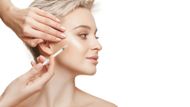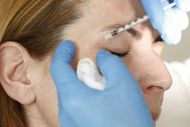Botox shots have increased in recent years, not just for cosmetic purposes but also for medical applications. The therapy consists of a purified type of neurotoxin, produced by the bacterium Clostridium botulinum, especially Type A, to temporarily immobilize muscles.
Although the vast majority of individuals understand Botox as a treatment for the smoothing of wrinkles and lines, it is used beyond that as a treatment. Botox brings temporary side effects and resolves themselves within a few days. Explore the treatments and side effects of Botox shots.
What are Botox Shots?
Botox shots inhibit the transmission of nerve signals, which are responsible for muscle contraction. This is done by using a toxin. They achieve this by temporarily relaxing some muscles, which also helps in smoothing lines and treating many medical conditions. As the needles are very thin, patients usually report no pain. Others report it as a pricking or pinching feeling, mild.

Raymond Price, MD, an associate professor of Neurology states:
“The idea is that Botox prevents nerve signals from firing that would normally be the root cause of these headaches, helping chronic migraine sufferers by stopping the pain before it starts. I’ve been thrilled with how many patients have seen dramatic reduction in their headache frequency.”
Read more: Benefit Cosmetics launches BadGal Bounce mascara: Where to buy, price, and more explored
Cosmetic Benefits of Botox shots
Botox is widely used to minimize signs of aging by reducing the appearance of wrinkles and fine lines on the face. Some of the most common treatment areas include:
- Forehead wrinkles - Lessen horizontal creases that occur as a result of expression and aging.
- Crow’s feet - Resolve lines of the iris around the outer orbital borders.
- Frown lines - Diminishes the deep vertical lines between the eyebrows.
- Lip lines - Reduce the fine lines adjacent to the mouth opening.
- Jawline and chin - Improves facial lines by relaxing certain muscles.
- Neck bands - Reduces the appearance of horizontal lines or tightening of the neck muscles.
Botox is a non-invasive option for surgical procedures for people wanting to look younger. However, results are temporary and typically last between three to six months.
Medical uses of Botox shots
Although Botox is most commonly recognized for its cosmetic role, it has been used in the treatment of diseases since the 1970s. Here are the major medical conditions for which Botox shots are effective:
Chronic Migraines
According to reports, a chronic migraine sufferer gets a botox, which might help reduce the pain. The treatment relieves headache frequency and intensity.
Hyperhidrosis (Excessive sweating)
Botox may provide relief for excessive sweating even in cooler temperatures by blocking the nerve signals that cause sweating.
Overactive Bladder
For individuals suffering from urinary incontinence or an overactive bladder, Botox can be helpful by relaxing the bladder muscles and reducing sudden urges to urinate.
Neck Spasms (Cervical Dystonia)
A painful condition with involuntary spasms in the neck that results in painful trunk movements. Botox might help by relaxing the affected muscles.
Eye Twitching
In cases where involuntary eye movements become persistent and interfere with daily activities, Botox can help ease the muscle contractions causing the twitching.
Pelvic Pain
Botox has been considered for treatment in patients with pelvic pain due to contraction of or spasms of pelvic muscles.
Albert D'Angelantonio, DPM, FACFAS, chief of Podiatry/Foot and Ankle Surgery in Plastic Surgery states:
“Patients who had uncontrolled blinking or had narrowed or closing eyelids were among the first to see the benefits of this treatment. The cosmetic uses of the treatment came afterward.”
How Botox Treatments Work?
When you get Botox, a doctor injects small amounts of the drug into certain spots using a pointed needle. You might need several shots, based on what you're treating. The procedure doesn't take long, and you can head home right after.
You may feel a bit of pain from the injections, like a little prick, but it goes away fast. To make you more comfortable, the doctor might put on a cream that numbs your skin.

Botox shots generally take less than 10 minutes to perform. This process consists of localizing particular muscles with a thin needle and injecting the neurotoxin. Having variability, however, with some individuals reporting improvements within days, full effects sometimes aren't obvious for up to a week.
For validation, further follow-up injections are necessary every 3-6 months, according to the individual's response to the injections, and the area to be treated.
Ariana L. Smith, MD, an associate professor of Urology and director of Pelvic Medicine and Reconstructive Surgery states:
“The injection allows the bladder to relax and fill up more before needing to go. It can also give patients greater control by restoring continence, which provides symptom relief.”
Possible side effects of Botox shots
Despite the safety of Botox being enjoyed when performed by a licensed, experienced provider, temporary side effects can occur. Some of the most common side effects include:
- Injection site pain or swelling - Mild stinging, bruising, or redness goes away in a few days.
- Flu-like symptoms - Some people might have mild flu-like symptoms within days after the shot.
- Headaches - People getting Botox for looks might get headaches.
- Neck pain - Some patients feel mild to moderate neck discomfort after the procedure.
- Drooping eyelids (ptosis) - If Botox moves to the wrong areas, it can make eyelids droop for a while.
- Eye irritation - Botox treatments can make some people's eyes red or dry.
- Indigestion Symptoms - A few people report slight stomach upset
.
It is important to inform a healthcare provider if Botox has been administered within the past four months or if the patient is taking blood thinners, as this may increase the risk of bruising at the injection site.
Botox shots have an impact on both looks and health making them a useful treatment option. Many people turn to Botox to look younger, while others count on it to ease long-lasting pain bad headaches, muscle twitches, and other health issues.
The treatment is safe and works well when done by skilled experts. If you are thinking about getting Botox shots, it's crucial to find a good healthcare provider to make sure it's safe and gives you the best results.
